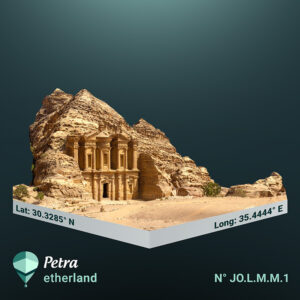 Petra, one of the World's Seven Wonders, was the capital of the Nabataean kingdom. Estimated to have settled in the area as early as the 4th century BC, the Nabateans layed through their capital city the foundations for a trading empire that would stretch as far as Syria. The name of the site comes from the Ancient Greek word for « rock », symbolizing the way the city is built in the sandstone.
Petra, one of the World's Seven Wonders, was the capital of the Nabataean kingdom. Estimated to have settled in the area as early as the 4th century BC, the Nabateans layed through their capital city the foundations for a trading empire that would stretch as far as Syria. The name of the site comes from the Ancient Greek word for « rock », symbolizing the way the city is built in the sandstone.
The city of Petra in Jordan is one of the most striking monuments on earth. It was built by the Nabateans, an Arab-Bedouin culture which flourished in parts of Sinai, Jordan and western Arabia between the fourth century BC and the fifth century AD. They began developing Petra around the second century BC and soon made it their capital. The Nabateans were a trading culture and controlled the caravan routes around this inhospitable part of the world, so Petra flourished as a trading hub for several centuries. The development of Petra reflects the wealth they accrued from this trade.
The city is cut into the rock formations next to the mountain of Jabal Al-Madbah, but it largely uses unique geographical formations as part of its design. Large passages and gorges here through the mountains cool the area and provide spaces into which buildings could be cut. The most well-known of these passages is a gorge that leads through the mountains to the city itself. Known as the ‘Siq’ or Shaft this is a narrow gorge passageway which runs for 1.2 kilometres from the countryside outside into the city of Petra. In places, it is as narrow as three or four meters.
The ‘Siq’ opens out into what is the most famous building in Petra. This is the ‘Al-Khazneh’ or ‘The Treasury’. It was built as a temple and was carved out of the sandstone rock faces which face the end of the ‘Siq’. It is typically understood to have been built by King Aretas IV, the ruler of the Nabateans in the first century AD, as his tomb or mausoleum. The front edifice here is richly decorated with Greek and Roman mythological scenes and Corinthian columns. It became known as ‘the Treasury’ in the nineteenth century as local Bedouins believed that there was treasure stored here.
From here, the city forks off left and right, and there are many other great buildings throughout, including a Roman amphitheater which was cut into the hillside. Elsewhere the Garden Complex is the remains of a large leisure area that the Nabateans built with gardens and even a swimming pool. This was possible here in the arid, desert-like conditions because the Nabateans had taken control of the local water supply and constructed an artificial oasis within Petra, which supplied the city with plentiful water.
Today Petra is one of the most famous tourist sites in the entire Middle East. It was designated as a UNESCO World Heritage Site in 1985 and receives over one million visitors annually, a significant number for a somewhat geographically wayward site. In 2007 Petra was also voted as one of the New Seven Wonders of the World, a list which was drawn up to replace the Old Wonders, six of which are no longer standing.